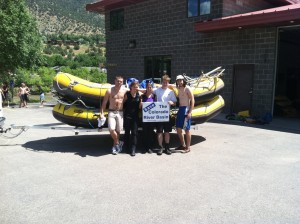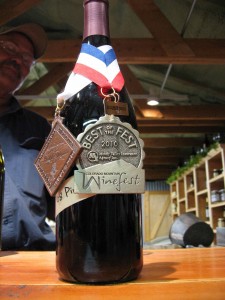Monday, July 11, 2011
Avon-Glenwood Springs-Aspen-Paonia
Morning on the Colorado

Departing early from the Hillman’s in Avon, we followed the Eagle River to the confluence with the Colorado. Continuing on to Glenwood Springs, we arrived at our outfitters for the morning: Whitewater Rafting, LLC. After a brief safety talk featuring the compulsory bad jokes, we climbed into a van with our guide, Levi, and another party.
Because the Colorado is very high right now—almost 20,000 cfs (cubic feet per second) below the confluence of the Roaring Fork—we were unable to go through the Shoshone rapids. Instead, we embarked from Bear Creek. The first big rapid we hit, Mine Shaft, nearly sent Warren and Carson into the drink. Though we hit some fun rapids after that, there were long stretches where we could talk with Levi.
We asked Levi about the impact of the Shoshone Dam, and he mentioned that it has been greatly beneficial to the rafting industry of Glenwood Springs. In order to generate power Shoshone needs to release a minimum of 1,200 cfs, guaranteeing enough water in the Colorado to raft. Since Shoshone is a top-release dam, it does not have the negative temperature effects of bottom-release dams like Glen Canyon: cold water equals a greater likelihood of hypothermia. Levi also told us about the ecology and hydrology of the river. One interesting fact he gave us is that the source of Glenwood hot springs is actually under the Colorado, the river was diverted in order to make the Glenwood Hot Springs pool, and the hot spring is the greatest natural source of salt on that section of the river.
Towards the end of our rafting adventure, we formed a trust circle. Holding on to each other’s shoulders, we stood on the edge of the raft while Levi spun us in a circle, gradually increasing speed. As we circled, we went past two juvenile Bald Eagles, undoubtedly laughing as the inevitable occurred: Sally and Warren fell out of the boat as our trust circle collapsed.
Recreation on and around the Colorado River has a significant economic impact, and can be a great ally of the environment. We would learn more about environmental and recreation groups working together to ensure in-stream flows when we visited the Black Canyon of the Gunnison National Park.
Afternoon in Aspen
We drove to Aspen in a light rainstorm. It is truly amazing how green the mountains and how full the rivers are. After a decade of drought we need the water, but we have to remember that one wet year does not end a drought.
In the afternoon we met with Auden Schendler, the Vice President for Sustainability at Aspen Ski Company. He gave an overview of Aspen’s sustainability efforts. First, Aspen performed some institutional greening: recycling programs, installing low-flush toilets, and so forth. They realized, however, that such small-scale effects alone would not have any impact on climate change. Climate change and the warming of much of the world could result in a shorter ski season and less snow, both of which would affect the ski industry.
Aspen then added efforts to reduce their carbon footprint by directly generating power from green sources as opposed to purchasing “meaningless” alternative energy certificates. But, Schendler told us, these small-scale efforts are not going to have any significant impact on mitigating climate change. Even if Aspen were to figure out a way to insure snow for skiing, Schendler noted that the decrease in socio-economic stability would decrease the number of people that could ski. If your town has flooded in North Dakota, or if your home was wiped out by a hurricane, you do not have the luxury to go on a ski trip.
With this in mind, Aspen has been using their leverage as a political and economic force (not to mention a vacation destination) to influence people who have the power to change the world. Aspen, along with over 700 other companies boycotted Kimberly Clark (Kleenex) because of their unsustainable forestry practices. Like magic, Aspen made national press and Kimberly Clark has since greened their operations.
Evening on the Farm

Shortly after six we pulled into Orchard Valley Farms and Black Bridge Winery in Paonia, CO. Owned by my great aunt and uncle Kathy and Lee Bradley, the farm has water rights to the Farmer’s Ditch—rights dating to 1890. Since western water law is based upon the doctrine of prior appropriation (“first in time, first in line”), these early water rights are vital to the farmers.
The Bradleys started farming apples in Orchard Valley Farms in 1991. They gradually replaced the apple trees with other crops until today; they grow cherries, peaches, wine grapes and some other produce that they sell at their market. We spoke with Lee and Kathy about their operation and sampled some of their produce.
Camping out in the peach orchard, we cooked brats over an open fire and roasted corn: a great end to a full day.
By Ben Taber, Colorado College State of the Rockies Project Researcher